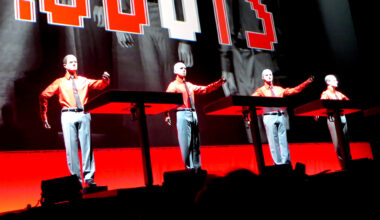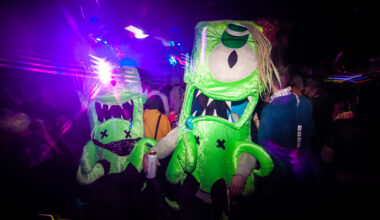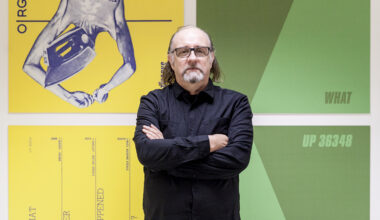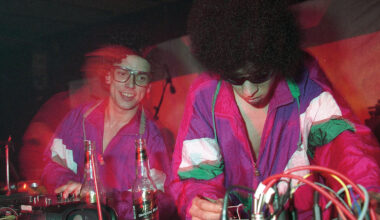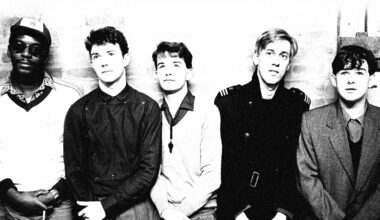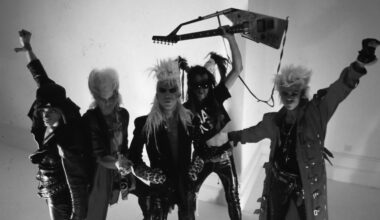Seven degrees of separation? How are Chris Frantz and Tina Weymouth of Talking Heads and Tom Tom Club connected to Brooklyn retro synth trailblazers Xeno & Oaklander? We unpick the tangled webs…
We first met Xeno & Oaklander back in 2014 when we visited their Brooklyn studio on the release of their third album ‘Par Avion’. The studio was (and still is) a chaotic Aladdin’s cave of rare synths and other music making gear, and exploring it occupied us for a good couple hours.
When we emerged blinking into the sunlight to get something to eat, an old Merc, circa 1976, pulled up alongside us as we walked. The driver was Xeno & Oaklander singer/synthesist Liz Wendelbo’s fiancée, Egan. They chatted for a few moments and he went on his way. Sean McBride, the other half of Xeno & Oaklander, mentioned that Egan was Chris Frantz and Tina Weymouth’s son, revealing a back story to which I had been entirely oblivious.
Fast forward a few months, and I discovered the Chris und Tina project via a short film produced by independent fashion brand L’École Des Femmes. I got in touch with Chris Frantz to find out more and got chatting about the family connection with Xeno & Oaklander. Roll on another a year or so, and the idea of bringing Chris und Tina and Xeno & Oaklander together on a split seven-inch for Electronic Sound occurred to us.
Chris, Tina, Liz and Sean were all excited by the idea, and so here we are. All we needed next was a cosy chat around the family dinner table, where the topics of conversation are Kraftwerk, Talking Heads, modular synths and how their life is a joyous tangle of art, music and love…
Chris and Tina
What was the first electronic music you encountered?
Chris: It was probably ‘Switched-On Bach’, but Kraftwerk was our first electronic music love. Sometime in the spring of 1974, Tina borrowed her family’s van to drive our Rhode Island School Of Design “Painting Club” the 200 miles to New York City to attend a John Cage performance at The Kitchen, which was still in SoHo at the time.
Tina: John Cage was an extraordinarily gracious artist. Following the performance, he gave everyone a mushroom and some white wine in paper medicine cups!
Chris: Afterwards, we went round the corner to the Spring Street Bar and someone put a handful of quarters into the jukebox and played ‘Autobahn’ over and over again. This was the first time we heard Kraftwerk. I was transfixed, the sound and vibe of the tune was a revelation to me.
Tina: I remember after we graduated from RISD and moved to SoHo, we spotted the ‘Autobahn’ LP in a lower East Village shop window and snapped it up.
Chris: Years later, at the Mudd Club, I heard ‘Warm Leatherette’ and ‘Don’t You Want Me’, both of which brought me great happiness.
Do you remember your first synth?
Tina: Chris, when we were still a trio in 1975 you switched from your drum kit to a portable electric vibraphone on a couple of songs, ‘First Week Last Week’ [From ‘77’] was one.
Chris: That was a little analogue drum machine made by Univox called a Rhythm Box. It had maybe a dozen presets, along with tone, volume and tempo dials. Our first real synth was a Prophet 5 made by Sequential Circuits. We were on tour with Talking Heads in California and our keyboard player, Jerry Harrison, said he wanted to stop and visit the guys who made them.
Tina: They offered to demo the Prophet 5 for him. That was in the fall of 1978 in support of our second album, ‘More Songs About Buildings And Food’.
Chris: I remember their little factory was in a garage somewhere in San Jose. We visited them and they were big fans of Talking Heads and they were very happy to build one for Jerry. It was mainly for Jerry’s use, but we all paid for it.
Tina: It was a big outlay for our band, $5,000, but Jerry loved it.
Introducing synths into Talking Heads signalled a major shift in trajectory, what can you remember about that process?
Tina: The idea behind getting the Prophet 5 was that we would add new and original sounds and textures to make our sets more dynamic and diverse. Up to then Jerry’s keyboards consisted of a Farfisa electric organ and a Fender keyboard, which recalled the garage bands of the 1960s. In buying a synthesiser, we didn’t want to be thought of as “prog rock” with all the sticky pretentions attached to the genre, to our way of thinking that would be worse than sounding retrograde! We remained hopeful that we might make something new, and the demonstration the guys from Sequential Circuits gave Jerry made us think we might be headed in the right direction with a more portable and versatile instrument than the clunky, behemoths our predecessors were using.

Chris: After we got the Prophet 5 it took Jerry along time to commit to using it.
Tina: We thought he could just plug it in and start playing, but noooo! We took turns hauling it up and down the staircases of motor inns so Jerry could learn to program it, alone, after shows. Every day we would ask, “Jerry, can we use the Prophet 5 tonight?”, and every day he’d say, “Not yet”. Weeks turned into months and still Jerry was not prepared to use it.
Chris: Finally, one day we asked him how it was going with the Prophet and he said, “I can play you the sound of a man pissing.”
Tina: You could build a new sound out of the Prophet’s presets, but Jerry was ambitiously thorough and felt he should start from scratch! One of our most successful songs used the Prophet 5 Preset 1-1. That was in 1981 for the little signature keyboard melody that Chris and I played together on ‘Genius Of Love’.
Chris: You also hear the Prophet 5 on ‘Wordy Rappinghood’ as well as just about every other Tom Tom Club song.
Did you think of Tom Tom Club as an electronic band?
Chris: Tom Tom Club has many electronic elements, but we’re not really what you’d call an electronic band. We like to draw from a multitude of sounds both electronic and organic. For example, we have used both the Moog Rogue and and bean pods to create textures in our recordings.
Your Chris und Tina project sounds like a nod to krautrock?
Chris: Ja! It was an easy leap from Chris and Tina to Chris und Tina. Kraftwerk has always been a source of inspiration, they are our electronic music ideal.
Tina: I can tell you a sort of funny/sad story about Kraftwerk. While on tour in Germany, around 1978 or 1979, someone from our German label arranged for us to meet Ralf… but it didn’t go very well at all. The meeting took place in what seemed an empty warehouse or in an industrial part of town. David Byrne had decided to come, but after the introductory handshakes he wandered off on his own to a far corner to stare at something invisible. I wonder if Ralf might have been offended so there was a little bit of small talk, but no joking around.
Curious about Kraftwerk’s methods, I made the terrible mistake of attempting to start an already awkward conversation by complimenting the lyrics before mentioning the music. Ralf scoffed with a vehemence that was like a slap. “They are just stupid!” he said, and then he turned on his heel without another word. It wasn’t until much later that we would meet their visual artist and lyric collaborator, Emil Schult. Emil didn’t mind that I liked his cover art and lyric contributions along with the music, and so we have remained friends.
It’s good to see the resurgence in analogue/modular set ups these days isn’t it?
Chris: Indeed, it is. I like the idea of people caring about sound. So much digital music is lacking depth and colour and we are in favour of high fidelity
Analogue synths are said to have a personality, is this an idea you recognise?
Chris: Yes, I get that. Every instrument has a personality and some are more interesting and fun than others. Analogue synths seem to have a richness and stronger depth of character that some digital synths. Having said that, the famous Duke Ellington quote, “If it sounds good, it is good”, comes to mind. The player has everything to do with it, too.
Tina: Houses can be said to have a soul, why not musical instruments? I believe we invest the instruments we play with a tiny bit of ourselves and they impact us in return. Some musicians I know have stuck by certain synth models well past their obsolescence based on their attachment to particular sound patches. They’re virtually married to their gear! So how will they handle the loss when they can no longer be repaired?
You’ve worked together pretty much your whole adult life, how’s the work/life balance?
Chris: I love working with Tina and I always have. It was my idea to bring her into Talking Heads and I was happy to continue to work with her in Tom Tom Club and Chris und Tina. She’s a woman of real talent, keen intelligence and strong opinions and I dig that. We just celebrated our 40th wedding anniversary. That was a very happy day for me… and I think also for her.
Tina: Aw, Chris! You are so romantic… and so smart. My very own genius! Of! Love! And an amazing chef, too. Those are just a few of the many reasons I adore you.
Xeno & Oaklander are a part of your actual family. what did you think when your son came home with a musician?
Chris: Well, Liz is not just any musician. She’s a serious artist, as well as a musician, she’s a photographer, writer, filmmaker, and she creates her own fragrances, which she sells in limited quantities. In other words, like Tina, she has many talents.
Tina: We could not be more delighted. She’s the daughter we never had and she is French! An ally! Liz’s calmness is only one of her many super powers. As our son, Egan, says, she is perfect. I love that. My mother, who was also French, always said that about my father, and their love endured for more than 70 years, so I take that as a good omen. Egan is a super brilliant artist who has continually surprised and challenged us to keep up with him since he was very small. We sometimes wondered what sort of woman would have the energy and intelligence to match his and let him be his own man, too. He’s lucky to have found a great partner in Liz. We have come to love her musical partner, Sean McBride, too. It’s rare good luck when you get to enjoy great talent wrapped up in great human beings. We will never take that for granted.
Do you think Xeno & Oaklander face the same challenges you did when you first set out?
Chris: I dig that Xeno & Oaklander bubble up from the underground. There is nothing mainstream or commercial about them. They have their own unique sound. I think any band faces enormous challenges to be successful, but they have a strong work ethic and a wonderful sense of adventure.
Tina: It’s somewhat different for artists today than it was for us, the basics for artists in any era are the same. They need to look after each other and stick together through hardships and successes alike. I think our generation of bands might have enjoyed the last of a golden century of music, when there was room for everyone and everyone who got good could give up his day job to make a modest living as an artist.
Is it interesting watching them develop? Do you see parallels between you careers?
Chris: It’s very interesting. Their most recent album, ‘Topiary’, is a quantum leap for them, but I’m confident their best is yet to come.
Tina: They play their music against a backdrop of beautiful film visuals that Liz makes while travelling. Hearing and watching them play and grow has been transformative for me as a fan. It’s like going up the elevator shaft of a building. When the elevator doors open, you find familiar themes, but the colour and tone has changed from the previous floor. The best art changes your perspective, so you never see things as you did before the experience. You can’t ask for more than that.
Xeno & Oaklander

What was the first electronic music you encountered?
Liz: Kraftwerk. I was hypnotised by their ‘Radio-Activity’ album. Something about the crackling Geiger counter sounds at the beginning of the album, the persistent bassline and the otherworldly synth voice captured my imagination as a child. I realised later that breath seems to play an important role in Kraftwerk’s music – maybe it’s something to do with riding bicycles, or movement of some sort, like in the Tour de France. Or wind instruments such as the flute on their first album. It felt somehow like Kraftwerk’s synths were living and breathing.
Do you remember your first synth?
Sean: I had attended a summer camp for music when I was 16 focusing on the trumpet and French horn and there I met a piano student who I became fast friends with. Months later I ended up trading my bass guitar for his Roland Alpha Juno 2 and so began this adventure.
Liz: I guess we both unconsciously go back to our first instruments, the trumpet for you and the flute for me, and apply some of those to synth textures we create: the flourishes, the horns. The classical arrangements in our latest album ‘Topiary’ in a manner of speaking is a return to our roots.
Why did you pick up on synths and not guitars?
Liz: Well actually we both used to play guitar before we started Xeno & Oaklander. I was in a girl band and Sean played in a kind of wall of noise shoegazer thing. I think you can still hear that influence in our music, there’s still some fuzz and note bending.
Sean: I had played bass guitar in my school’s jazz band for a few years. At the same time I encountered my first modular synths in university I was very much interested in the guitar as a noise making device. Projects such as Sonic Boom, Flying Saucer Attack as well Faust and Can were quite formative examples of how the guitar and the synthesiser lay at a kind of experimental musical and textural crossroads. I think that the guitar on many levels is maybe more of a direct ancestor to the synthesiser than possibly even the piano or organ.
Analogue synths are said to have a personality, is this an idea you recognise?
Sean: Absolutely. Although I think contemporary SMT [surface mount technology] based modules for example lack the personality of what was once a hand-wired, hand-built affair. I do realise using robots to assemble circuit boards in China is far more cost effective than having real people do the work. Funny aside, my friend brought his Roland System 100m in for repair years ago and the Japanese synth tech here in New York upon opening the system realised he himself was the one who had hand assembled it in 1980 when he worked at Roland as a young man.
Sean, what did you think when Liz turned up with a Talking Head offspring?
Sean: Xeno & Oaklander has always crossed-over between art and music. Egan Frantz is a New York-based artist, he paints and makes sculptures, it’s minimalist – just like our music. Egan joined our ranks as a sound engineer pretty much immediately upon meeting. He has a natural understanding of electronic music and he is a very good listener, so this symbiosis makes sense. Music informs his art and his art informs our music.
Liz: With Xeno & Oaklander, electronic music is a way of being, it’s a lifestyle. It’s synesthetic: it appeals to all the senses, it crosses all the borders of art, fragrance, film, light to ultimately transport the audience. Electronic music is also a community and a family. The commitment is all-engulfing. Sean, Egan, his family and me are living and breathing music and art 24 hours a day.
It’s relatively unusual to be so intimately connected to such well-known musicians, has it had an impact on the way you work?
Liz: Absolutely yes, Chris and Tina have been instrumental in helping out, and particularly in regards to the mixing studio. We’ve learnt a lot from working at their amazing Clubhouse Studio (we recorded and mixed our latest album ‘Topiary’ there), which inspired us to create our own too, it’s called Open Gate Studio. They’ve pretty much redefined the meaning of a home studio for me: a studio is a way of living. We’ve also learnt from Chris and Tina that music is a family thing.
Do you talk about the musical world Chris and Tina operated in? do you recognise it?
Liz: 1977 was a seminal year for music, that’s the year the first Talking Heads album ‘77’ came out. Truly magical in that history, art and music aligned at this one specific moment in time. The fascination for me about the album is also the fact that the music that came from art (the band met at RISD art school) was readily available and played on the radio for all to listen. The bridge between music and art was crossed. We’re now in 2017 and the musical world that I know is operating primarily on an independent level.
Sean: Our minimal synth community is composed of many people from many different walks of life and backgrounds the world over. There is the desire for our music to exist and develop naturally without concessions but to also maintain and be mindful of its DNA, it’s heritage.

